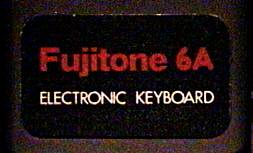
| FM keyboard with great tekkno sounds |
| Did you expect that Fujitone
or MC-... keyboards have only squarewave or thin toy organ sample
sounds?!?
Then you never heard a Fujitone 6A! |
 |
|
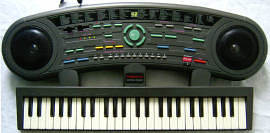 |
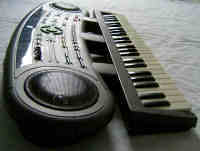 |
The Fujitone 6A sounds similar like a high quality Yamaha PortaSound FM keyboard, but with 100 all different preset sounds. Though also for owners of a newer original FM PortaSound (even when it is a programmable synthesizer like PSS-390 or PSS-780) this keyboard can still enrich your sound library. The preset sound names of the Fujitone 6A correspond to the Yamaha PSS-170 from 1986, but their order is different and I don't know if there are other similarities since I don't own the latter. But I bought later a Yamaha VSS-200, which includes many effect sound presets those have the same names and are very similar (partly even identical) with the Fujitone 6A (e.g. comet, crystal, drip, fireworks, leaf spring, handsaw, hand bell, gurgle, human voice 1..3, ice block, metallic synth, popcorn, rain drop - although the VSS-200 features no 4 operator sounds and sounds rougher/ more digital). Thus I conclude that also the presets of the 6A are likely based on old Yamaha instruments. The 6A timbres are programmed less natural than the those of my other Yamaha FM PortaSounds, but the sounds are warmer despite both use very similar FM hardware. (The warm sound may have to do with a lower modulation parameter setting of the FM preset sounds, but I think that also the internal amplifier is a little less harsh than the Yamahas.)
The only bad thing is that the light grey text on its dark grey front panel becomes invisible under any non- optimal light conditions. Also the 9V AC adapter input jack breaks repeatedly and needs to be re-soldered. When I got mine, also one speaker distorted because it was bent; after bending it back, the sound got very clear now. Unlike late FM PortaSounds, the Fujitone 6A also does not include any sequencers nor "custom drummer" nor the great "duet", "dual voice" or "key split" features from Yamaha, but it looks great, sounds fantastic and costed new only about half as much.
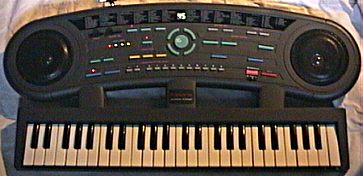 |
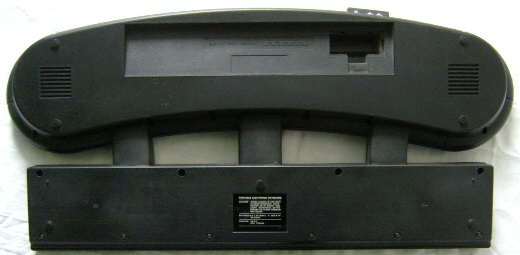 |
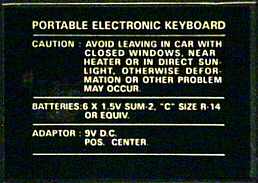 |
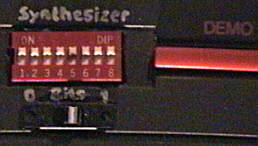 |
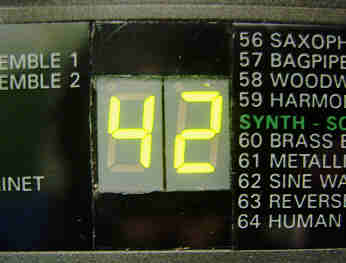 |
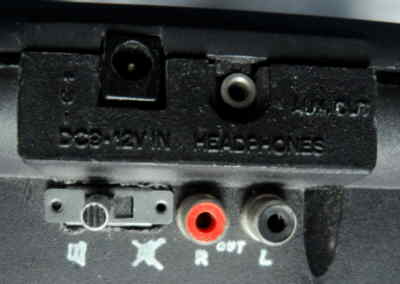 |
"piano" 1..2 are the usual FM e-pianos with dull bass range; 2 is brighter. "electric piano" 1 is a rhodes timbre with mild 4Hz vibrato; 2 is more nasal and brassy. The "harpsichord" 1 has clicking attack and a hollow bass range; 2 is brighter and 3 has shorter envelope (like a banjo). The "glass celesta" has long sustain and 4Hz tremolo. "pipe organ" 1 is a dull metal pipe organ rank with short sustain; 2 is brighter. "electronic organ" 1 is a plain tooting Hammond timbre with dull bass range; 2 (d) is similar with chorus effect. "jazz organ" is a plain Hammond timbre with clicking attack. "accordion" (d) has chorus effect and slightly hollow bass range. "flute & harpsichord", "oboe & vibraphone", "clarinet & harp", "violin & steel drum" use (d). These dual instrument voices generally sound barely realistic; in "violin & steel drum" with low notes the steel drum rather becomes a timpani. The "violin" 1 is a static toot tone without any vibrato; 2 is brighter and thinner. "cello" is also just a toot tone and resembles a warm and bassy reed organ. "strings" (d) has a warm and quite noble sounding massive chorus effect with a granular texture, that switches the timbre with 4Hz like a sort of phasing. The "electric bass" sounds a bit hollow. "synth bass" resembles a bowed bass with slow attack; it then decays and holds the note with slightly brassy timbre. "slap bass" is a fast decaying funky e-bass with clicking attack (not really realistic). "wood bass" sounds warm and a little brassy. "synth bass" has brassy timbre and decays with strong 4Hz wahwah. The "banjo" sounds more like a bright nylon guitar. The "mandolin" (d) rings with 6Hz and chorus effect; bass range is dull. The "classic guitar" sounds way too brassy (rather a synth brass that turns duller and decays). The "jazz guitar" is yet another hollow FM e-piano with 4Hz tremolo. "folk guitar" is rather a semi-brassy clavinet with hollow bass range. The "hawaiian guitar" sounds rather thin with strong 4Hz tremolo and grainy bass range (a bit squarewave- like?). "ukulele" sounds bright and thin (rather a banjo); lower notes turn brassy. The "koto" has impulsive attack and sounds brassy with hollow bass range (fairly realistic?); "shamisen" is the same with much shorter decay (like a picked violin). The "harp" has soft attack and sounds too brassy and more like an e-bass. "handsaw" is a very bright, thin and resonant, slightly disharmonic metallic synth sound that goes "woinnng"; during its slow decay it turns thinner. The "trumpet" sounds a little fat, the "mute trumpet" more like a french horn. "trombone" is an even fatter french horn (or tuba?) and "soft trombone" the same in duller (make a nicely warm organ bass). "horn" is a less fat french horn. The "alpenhorn" sounds dull and nicely warm; its slow attack has some crackling zipper noise in low notes. The "brass ensemble" 1 (d) has gritty chorus; 2 (d) has additionally a sonorous bass voice (tuba?). "flute" is a metal flute with dull bass range. The "panflute" has too little wind noise. The "oboe" sounds bright and (too?) thin at high notes. "bassoon" has a nice sonorous bass range; high notes resemble an oboe. The "saxophone" is a little dull. The "bagpipe" sounds thin with too slow attack and strong 4Hz tremolo (very unrealistic); the bass range is nicely woody and sonorous. "woodwinds" (d) has chorus with sonorous bass range; high notes are bright. The "harmonica" sounds a bit hollow with slow attack and 4Hz tremolo (fairly unrealistic). "brass ensemble" 3 (d) has a tuba timbre with the gritty chorus.
"metallic synth" is a fat and metallic synth brass that goes: "baaouummm" and fades duller. "reverse" is a semi- voice- like hum that fades louder with zipper noise and than stops. "human voice" 1..3 are synth voices those barely sound like expected. 1 sounds bright and thin with long notes, and has more chorus tremolo with short notes; 2 has always 4Hz chorus tremolo. 3 is always thin without tremolo and resembles a "vox humana" pipe organ rank. "whisper" sounds like a flute with slow attack (with zipper noise) and long sustain. "whistle" resembles a high sine wave tone with slightly scratchy attack. "gurgle" is a semi- voice- like synth noise with wahwah tremolo going: "boahwahwahwa..." that slowly fades silent. "bubble" is a synth guitar (made from a sawtooth wave?) that resembles a fuzz distorted acoustic guitar; the attack in bass range pops a bit. "raindrop" is a double tone consisting of a low short note followed by a longer 1 octave higher note played with a dull synth xylophone timbre. "popcorn" is a short synth brass sound that goes "boang". "drip" is a bubbling synth brass that goes: "browmmm". "dog pianist" (d) is an FM e-piano layered with a thin and squawky wannabe human voice timbre (like a vox humana pipe organ rank). "duck" is a squawky synth trumpet with bubbling attack that goes: "boaaaa...". "baby doll" is a thin music box timbre with long sustain (like a clock chime). "music box" sounds more like a glockenspiel - lower notes like clanging on ceramic vessels, bass range is dull. "honky - tonk clavi" (d) is a piano with halfway voice- like chorus and dull bass range. "honky - tonk piano" (d) sounds like "piano 2" with additional chorus effect. The "vibraphone" has a 4Hz tremolo. "marimba" 1 sounds quite dull (like made from sine wave) with clicking attack and fast decaying envelope; 2 employs the same sound, but rings with a 6Hz trill of 2 alternating notes with 1 octave distance (much like the synth effect sounds on Casio VL-1). "chimes" is similar like "baby doll", but has more disharmonic overtones (like certain rod based clock chimes or toy pianos) and plays 1 octave lower; the soft attack sounds unrealistic. "bell" is a very unrealistic nasal synth bell with cold chorus and strong 4Hz wahwah tremolo (a bit like a big Buddhist monastery bell droning in a cave or the like). The "steel drum" decays way too fast (like damped by a piece of felt or the like). "cowbell" sounds more like a xylophone; bass range is dull. "synth tom" 1 has a fast falling pitch that goes: "piu" with higher notes (a bit like the synth tom in the arcade videogame Reactor); the bass range sounds like a normal drum. 2 has a more nasal timbre (like when 1 would be resampled at low resolution) and with held notes repeats with 4Hz (much like the Casio SK-1 "drums" sound). The "snare drum" is made from white noise layered with a weak melodic tone. It resembles a bit a typewriter noise, and long key presses play shorter than short ones. Playing polyphonic notes sometimes omits the white noise part, which produces interesting semi- random sounds.
The "telephone bell" is a mechanical one that rings very fast (about 8Hz?) with buzz from the clicking attack; bass range sounds hollow. "emergency alarm" is a fat and grainy roaring synth brass siren effect that howls with 3Hz and fades duller while it slowly decays. Especially the bass range is very disharmonic and sounds like a horror movie effect. "leaf spring" is a bright and thin metallic sound; it resembles "handsaw", but has a brighter and more impulsive attack that goes :"boieeeennng". "comet" is an arpeggiator synth pattern that cycles with 4Hz between 3 notes {initial octave, -5 semitones, -1 octave} while it slowly fades silent. "fireworks" is a granular synth timbre that steps brighter (first with 4Hz, then faster) and turns into a burst of white noise that fades silent. "crystal" resembles "marimba 2" (rings with a 6Hz trill of 2 alternating notes with 1 octave distance), but has a brighter timbre and slowly fades silent with much sustain, while it keeps ringing. "ghost" is a howling synth sound that pitch bends up and down again and then cycles with a gritty vibrato texture while it decays (also during sustain). "hand bell" is a metallic granular synth sound that starts dull with a soft pop noise (like "marimba 1") and then fades louder while it rhythmically steps brighter; at the end it quickly turns duller again and fades silent. The "machine gun" is a hammering white noise pattern that resembles a snare drumroll and cycles with about 6Hz. "wave" is an ocean wave made from white noise that quickly grows louder and then very slowly fades silent. Like with "machine gun" the played note pitch has only very subtle effect on the timbre, but pressing multiple keys makes it swell much louder. The vibrato button adds a square 6Hz vibrato to all preset sounds; with some of them (e.g. "oboe") it even makes thin timbres somehow fatter, almost like a rotary speaker effect. The sustain button adds sustain; the intensity of both effects depend on the preset sound.
The percussion has the typical electronic FM timbre known from the OPL3 "MIDI synth" of early PC soundcards. The accompaniment patterns are quite standard but the rhythms have each an intro (without accompaniment) and fill-in (with accompaniment). The accompaniment accepts in fingered mode beside standard chords also wild disharmonic note combinations. With rhythm off, there is a manual chord mode, which timbre depends on the currently selected preset rhythm. There are separate digital volume controls for rhythm and accompaniment channel, those can also mute them. The rhythm pattern switches immediately the next step as soon a new rhythm number is entered.
Like with some older Yamaha keyboards (e.g. MK-100),
during rhythm a walking light LED row (1 red, 3 green LEDs) flashes instead
of the usual "synchro" LED. Playing on drumpads permanently occupies 1
polyphony channel and lights the "percus off" LED. Press the "percus off"
button to free the channel again. This bizarre feature was likely implemented
to save RAM or CPU capacity by avoiding a timer that frees the channel
automatically.
circuit bending detailsThe Fujitone 6A is based on the CPU "MC-68" (42 pin DIL, crystal clocked @ 3.58 MHz) with FM sound IC "MC-9003A" (24 pin DIL).The CPU is likely a software variant of the "MC-3DX"
found in MC-3 hardware. Someone e-mailed me that the "MC-9003A" may be
technically identical with Yamaha YM2413. Traktor wrote me that
his First MC-6A (labelled only "First" on instrument, "MC-6A" on
the box) contains an "MC9003" (without the A).
It may be that the chorus parts would be anyway identical with my Thompsonic TS-61 (MC-6961 hardware); yet I haven't analyzed this further. keyboard matrixI initially did not write down the key order, so I re-sorted the table by cipher buttons. The keyboard layout has similarities with MC-3 except that it uses the additional pin 30 to support 61 keys. Other eastereggs are only the demo keys on/off button and a stereo chorus button (useless without hardware).
The input lines are active-low, i.e. react on GND. Any functions can
be triggered by a non- locking switch in series to a diode from one "in"
to one "out" pin.
A button at 8->37 activates keyboard play during demo and deactivates it when demo is off. Press it again to return to normal behaviour. This may be a test function, but might also be reserved for sequencer add-ons.
simple FM synthesizerTo install a DipShit synth, cut the data lines between CPU and FM soundchip (at this soundchip pin 2, 3, 4, 6, 7, 8, 22, 23) and solder an 8er DIP switch block into the cut data lines in a way that the closed switches re-connect them like before. (I connected DIP switch 1 to 8 with soundchip pins 2 to 23 in ascending order.) Add 8 pullup resistors (each 22 kOhm) to the soundchip side of these lines. The other ends of these resistors are soldered together and connected with the output of an alternating switch that switches between GND and +5V. This way soundchip bits can be modified by opening any of the DIP switches, which sets them all to the value of the alternating switch (0 or 1) by the low current through the pullup resistors.
So long no keys are pressed and no rhythm is running while DIP switches are open, the behaviour of the synthesizer is even so well reproducible that you can write down your own library of synthesized sound by noting the initially selected preset sound, the DIP switch setting, the 2nd selected sound and possible vibrato/ drumpad presses after closing the DIP switches. (You can also select more than 1 new preset sound in sequence to synthesize a new sound.) This easy modification can be likely added to any old Yamaha home keyboard with separate FM soundchip and it provides you a universe of new exciting sounds to explore for only about 3€. LED displayDespite the hardware was prepared for an LED display, it was omitted in most variants to cut cost. Without display it is awkward to find out which preset sound or parameter settings (volume, tempo, etc.) are currently used. The display segments are multiplexed with the 8 keyboard matrix out pins 34..42, to be demultiplexed by pin 27 (digit 1=right) and 28 (digit 2=left).
You will need 2 pieces 7-segment display with common + line. (I used 2 small green ones.)
(Sorry, my hand written notes and schematics are a mess. I hope this can help anybody.) |
The Fujitone 6A (without display) was also released as Alba KB 81, Fujiya MC-6A, Fujiyama 6A, First Austria MC6A, Kansai KS-6A, Levis MC-6A, Mega MC-6A, Thompsonic TS-06 and Yamashiba YA-12. Someone e-mailed me that it was released first as Fujiyama 6A. Also a version labelled First was made. Also the early version(?) of Radio Shack - Concertmate 580 used this hardware. A version with additional red LED display was released as Medeli MC-6 and Passenger's MC-6S (seen on eBay). I was told by e-mail that the Passengers MC-6S includes the missing analogue stereo chorus hardware. In the year 2002 I saw a Medeli MC-6 in a shop near the Reeperbahn in Hamburg for only 79 DM (39€). Regarding the CPU type label, also a variant called "MC-68" may exist, which appears to be the genuine name of this hardware class.
There was also a fullsize key variant released as Fujitone 6B (FM version with display) and Medeli MC-6B (no display) which had a boring, black, rectangular case and the famous analogue pseudo-stereo rotary speaker effect that is known from early Yamaha keyboards (stereo chorus, often called "stereo symphonic"). This Fujitone seems to be ultra-rare now.
_boxPart_s.jpeg) |
_s.jpeg)
Fujitone 6B FM version & MC-6B (eBay photos) |
_s.jpeg)
Fujitone 6B squarewave version (eBay photo) |
An ultra-rare transparent violet variant with different preset sounds and 20 rhythms was released as Kaysound MC-6A and likely others. Both hardware classes can be distinguished by 20 instead of 15 rhythms names on the panel.
A close relative with 61 midsize keys, MIDI- out and 40 rhythms was theMedeli MC-6961 (also released as Thompsonic TS-61 (I own one), Pearl PKB-L1 / MC-6961 and Pan Toys MC-6961 | similar 100 sound bank in different order, 6 demos, red LED display - seen on eBay). A fullsize variant of it was apparently the Pearl PKB-XL1-61 (with also MIDI- in). A technically direct predecessor of the Fujitone 6A was the GPM MC-5000, which has similar FM hardware but case and operating concept like an MC-3. Another close predecessor may be the Superb Sound EK-905 (100 sound bank full of noisy glitches, no drumpads, portamento).
Due to strong similarities I only mention the differences to the Fujitone 6A.
 |
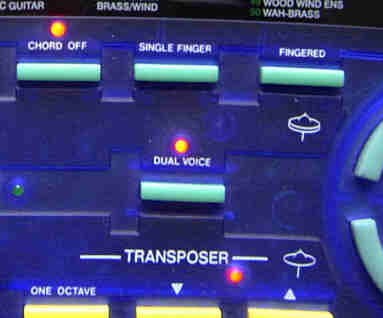 |
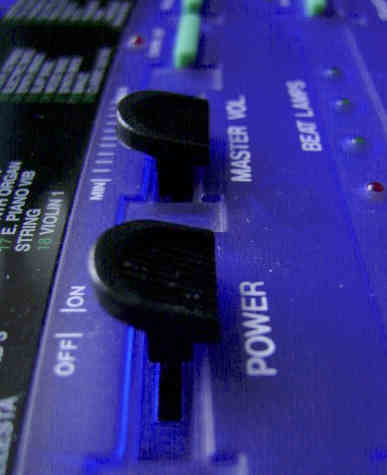 |
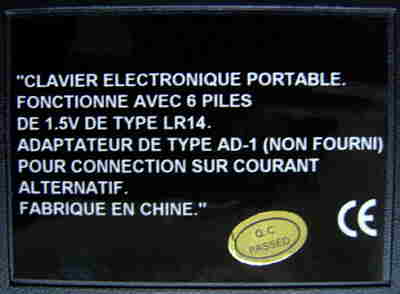 |
hardware detailsThe Kaysound MC-6A has similar PCBs like Fujitone 6A (see there), but different CPU "MC-68B" (64 pin SDIL) and also the FM sound IC "MC-9008" has 40 instead of 24 pins.
|
Regard that most keyboards named "MC-6A" are based on Fujitone
6A hardware. The hardware classes can be distinguished by the count
of preset rhythms (20 instead of 15) and presence of a "dual voice" button.
A grey case version of Kaysound MC-6A was released by Radio Shackas
Concertmate
580 (aka
RSC-580); internet photos and descriptions mention
that it has 20 preset rhythms, however the downloadable manual says 16
rhythms, thus an earlier version was likely identical with my Fujitone
6A. A grey version was also released by First Austria (seen on eBay).
| removal of these screws voids warranty... | ||
 |
||
|
|